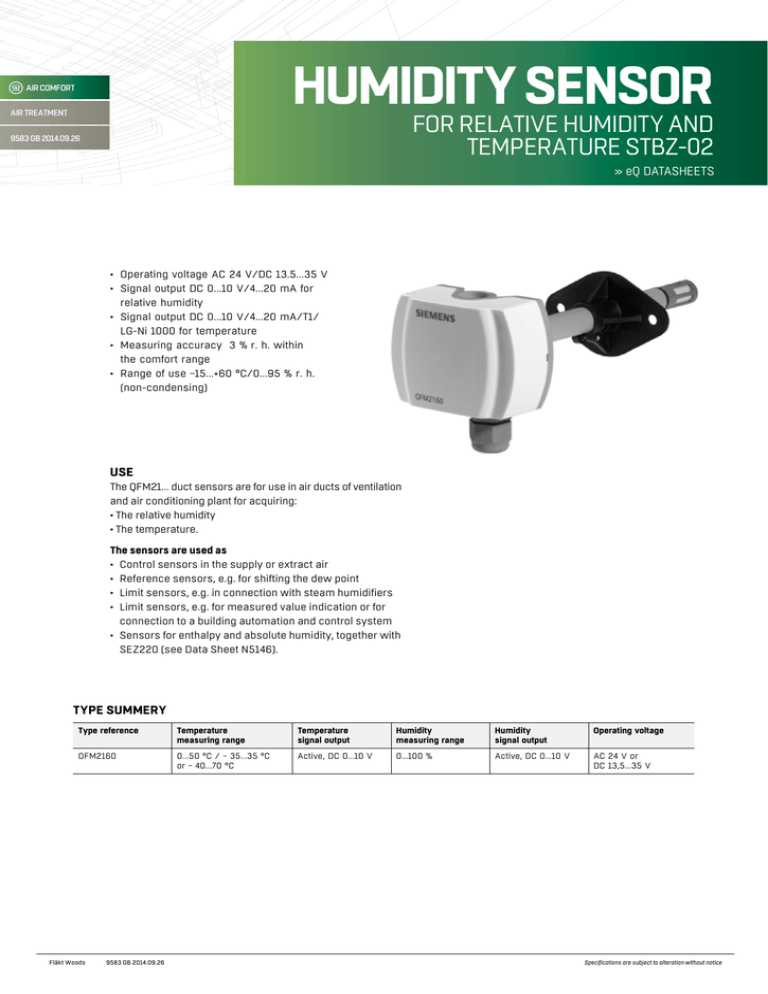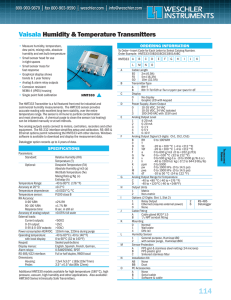HumidiTy sensOr
advertisement

Humidity sensor Air Comfort Air treatment for relative humidity and temperature STBZ-02 9583 GB 2014.09.26 » eQ DATASHEETS • • • • • Operating voltage AC 24 V/DC 13.5...35 V Signal output DC 0...10 V/4…20 mA for relative humidity Signal output DC 0...10 V/4…20 mA/T1/ LG-Ni 1000 for temperature Measuring accuracy ±3 % r. h. within the comfort range Range of use −15…+60 °C/0…95 % r. h. (non-condensing) use The QFM21… duct sensors are for use in air ducts of ventilation and air conditioning plant for acquiring: • The relative humidity • The temperature. The sensors are used as • Control sensors in the supply or extract air • Reference sensors, e.g. for shifting the dew point • Limit sensors, e.g. in connection with steam humidifiers • Limit sensors, e.g. for measured value indication or for connection to a building automation and control system • Sensors for enthalpy and absolute humidity, together with SEZ220 (see Data Sheet N5146). type summery Type reference Temperature measuring range Temperature signal output Humidity measuring range Humidity signal output Operating voltage OFM2160 0...50 °C / − 35...35 °C or − 40...70 °C Active, DC 0...10 V 0...100 % Active, DC 0...10 V AC 24 V or DC 13,5…35 V Fläkt Woods 9583 GB 2014.09.26 Specifications are subject to alteration without notice 2 Function Relative humidity The sensor acquires the relative humidity in the air duct via its capacitive humidity sensing element whose electrical capacitance changes as a function of the relative humidity. The electronic measuring circuit converts the sensor’s signal to a continuous DC 0...10 V signal, which corresponds to 0...100 % r. h. Temperature The sensor acquires the temperature in the air duct via its sensing element whose electrical resistance changes as a function of the temperature. Depending on the type of sensor this change in resistance is converted either to an active DC 0…10 V or 4…20 mA output signal corresponding to a temperature range of 0… 50 °C, –35…+35 °C, or −40...+70 °C. The measuring range can be selected. Mechanical design The duct sensor consists of a housing, a printed circuit board, connection terminals, a mounting flange and an immersion rod having a measuring tip. The 2-sectional housing comprises a base and a removable cover (snap-on design). The measuring circuit and the setting element are located on the printed circuit board inside the cover, the connection terminals on the base. The sensing elements are located at the end of the measuring tip and protected by a filter cap. Cable entry is made via the screwed cable gland M16 supplied with the sensor. Immersion rod and housing are made of plastic and are rigidly connected. The sensor is fitted with the mounting flange supplied with the sensor. The flange is to be placed over the immersion rod and then secured in accordance with the required immersion length. Fläkt Woods 9583 GB 2014.10.03 Setting element Mätområde 1|2|3 Testfunktion aktiv U1 U2 10 V 5V BS-MS I1 20 °C 20 mA I2 12 mA 5 V 10 V 75 °C 12 mA 20 mA 0V 5V 20 °C 4 mA 12 mA 5V 0V –35 °C 12 mA 4 mA The setting element is located inside the cover. It comprises 6 pins and a jumper. It is used to select the required measuring range and to activate the test function. The different jumper settings have the following meaning: • For the passive temperature measuring range: Jumper in the middle position (R2) = −35...+50 °C (factory setting) • For the active temperature measuring range: Jumper in the left position (R1) = −35...+35 °C, Jumper in the middle position (R2) = 0...50 °C (factory setting) Jumper in the right position (R3) = −40...+70 °C • For activating the test function: Jumper in the horizontal position: The values according to the table ”Test function active” will be made available at the signal output. Malfunction • Should the temperature sensor become faulty a voltage of 0 V (4 mA) will be applied at signal output U2 (I2) or signal output BS-MS becomes high impedance (>1 MΩ) after 60 seconds, and the humidity signal at signal output U1 (I1) will reach 10 V (20 mA). • Should the humidity sensor become faulty a voltage of 10 V (20 mA) will be applied at signal output U1 (I1) after 60 seconds, and the temperature signal will remain active. Specifications are subject to alteration without notice 3 Engineering notes A transformer for safety extra low-voltage (SELV) with separate windings for 100 % duty is required to power the sensor. When sizing and protecting the transformer, local safety regulations must be complied with. When sizing the transformer, the power consumption of the duct sensor must be taken into consideration. For correct wiring, refer to the Data Sheets of the devices with which the sensor is used. The permissible cable lengths must be considered. Cable routing and cable selection It must be considered for routing of cables that the longer the cables run side by side and the smaller the distance between them, the greater electrical interference. Shielded cables must be used in environments with EMC problems. Twisted pair cables are required for the secondary supply lines and the signal lines. Commissioning notes Important! Check wiring before switching on power. The temperature measuring range must be selected on the sensor, if required. Wiring and the output signals can be checked by making use of the test function (refer to ”Mechanical design”). We recommend not to use voltmeters or ohmmeters directly at the sensing element. In the case of the simulated passive output signals, measurements with commercially available meters cannot be made (measuring current too small). Mounting notes Location Mount the sensor in the center of the duct wall. If used together with steam humidifiers, the minimum distance after the humidifier must be 3 m to max 10 m. Fit the sensor in the extract air duct if the application involves dew point shifting. Fit only the flange to the duct wall. The sensor is then inserted through the flange and engaged. Caution! • To ensure degree of protection IP 54, fit the sensor with the cable entry pointing downward. • The sensing elements inside the measuring tip are sensi tive to impact. Avoid any impact on mounting. Mounting instructions The mounting instructions are printed on the inside of the package of the device. Fläkt Woods 9583 GB 2014.10.03 Specifications are subject to alteration without notice 4 Technical data Operating voltage AC 24 V ±20 % or DC 13,5...35 V Frequency 50/60 Hz at AC 24 V Power consumption ≤1 VA Cable lengths for measuring signal Perm. cable lengths See data sheet of the device handling the signal Functional data of humidity sensor Range of use 0…95 % r. h. (non-condensing) Measuring range 0…100 % r. h. Measuring accuracy at 23 °C and AC/DC 24 V in 0...95 % r. h. 30...70 % r. h. ± ±5 % r. h. ±3 % r. h. typically Temperature dependency ≤0.1 % r. h./°C Time constant at 0...50 °C and 10...80 % r.h. < 20 s Perm. air velocity 20 m/s Output signal, linear (terminal U1) DC 0...10 V 0...100 % r. h. max. ±1 mA Output signal, linear (terminal I1) Burden 4…20 mA 0...100 % r. h. See ”Function” Measuring range 0...50 °C (R2 = factory setting), −35...+35 °C (R1) or −40…+70 °C (R3) Sensing element NTC 10 kΩ Measuring accuracy at AC/DC 24 V in 15...35 °C −35...50 °C ±0,8 K ±1 K Time constant < 3,5 min in with 2 m/s moved air Output signal, linear (terminal U2) DC 0...10 V 0...50 °C / − 35...35 °C / −40...70 °C max. ±1 mA Output signal, linear (terminal I2) 4…20 mA 0...50 °C / − 35...35 °C / −40...70 °C See ”Function” Power supply Functional data of temperature sensor with QFM2160, QFM2171 Burden Fläkt Woods 9583 GB 2014.10.03 Specifications are subject to alteration without notice 5 Technical data Protective data Electrical connections Environmental conditions Materials and colors Standards and directives Degree of protection of housing IP 54 as per IEC 60 529 in built-in state Safety class III as per EN 60 730 Connection terminals for 1 × 2,5 mm2 or 2 × 1,5 mm2 Cable entry gland (enclosed) M 16 x 1,5 Operation Climatic conditions Temperature (housing with electronics) Humidity Mechanical conditions IEC 60721-3-3 Class 3K5 −15...+60 °C 0...95 % r. h. (non-condensing) Class 3M2 Transport Climatic conditions Temperature Humidity Mechanical conditions IEC 60721-3-2 Class 2K3 −25...+70 °C <95 % r. h. Class 2M2 Base Polykarbonat, RAL 7001 (silver-grey) Cover Polykarbonat, RAL 7035 (light-grey) Immersion rod Polykarbonat, RAL 7001 (silver-grey) Filter cap Polykarbonat, RAL 7001 (silver-grey) Mounting flange PA 66– GF35, (black) Cable entry gland PA, RAL 7035 (light-grey) Sensor (complete assembly) Silicone-free Packaging Corrugated cardboard Product standard: Automatic electrical controls for household and similar use EN 60 730-1 Electromagnetic compatibility Immunity Emissions EN 61 000-6-1 EN 61 000-6-3 - conformity to EMC directive 2004/108/EC - C-tick conformity (EMC) to EN 61 000-6-3 - conformity UL 873 1) Environmental compatibility Environmental product declaration CE1E1864en provides information on environmentally compatible product design and assessment (RoHS compliance, composition of substances, packaging, environmental benefit, disposal). ISO 14001 (environment) ISO 9001 (quality) SN 36350 (environmental comp. products) RL 2002/95/EC (RoHS) Weight Incl. packaging QFM21… Approx. 0.18 kg Fläkt Woods 9583 GB 2014.10.03 Specifications are subject to alteration without notice 6 Connection terminals QFM2160 QFM2140* QFM2100 (RF) (RF) QFM2101 (RF) QFM2171 G, G0 Operating voltage AC 24 V (SELV) or DC 13.5...35 V G1, G2 (RF)Operating voltage DC 13.5...35 V (RF) U1 Signal output DC 0...10 V for 0...100 % r. h. U2 Signal output DC 0...10 V for temperature range 0...50 °C (R2 = factory setting), −35...+ 35 °C (R1) or −40...+70 °C (R3) I1 Signal output 4…20 mA for 0...100 % r. h. I2 Signal output 4…20 mA for temperature range 0...50 °C (R2 = factory setting), −35...+ 35 °C (R1) or −40...+ 70 °C (R3) BS, MS Signal output LG-Ni 1000- or T1 for temperature range −35...+ 50 °C (passive, simulated); wires must not be interchanged Dimensions (Dimensions in mm) QFM.. 60 (62,8) 28 222 ø 20 Fläkt Woods 9583 GB 2014.10.03 50 21 (16) 60 min. 90, max. 154 183 80 ø 15 M16 x 1,5 3 28 14,5 (41) 39 80 Drilling plan with (without) mounting flange Specifications are subject to alteration without notice




